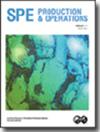Kaolinite Effects on Injectivity Impairment: Field Evidence and Laboratory Results
IF 1.3
4区 工程技术
Q2 ENGINEERING, PETROLEUM
引用次数: 0
Abstract
Summary Clay interaction with fluids is a well-known phenomenon that depends on formation mineralogy. This paper focuses on the impact of kaolinite clay dispersion on well injectivity impairment. It is based on field evidence from more than 50 injectors, and it is supported by a huge set of laboratory tests. All analyzed wells showed an initial injectivity lower than the theoretical potential, estimated on the basis of reservoir quality and drawdown mobilities (DDMs). This impairment occurs before connecting wells to the injection network; therefore, injected water quality and network conditions do not take part in the damage. Consequently, the impairment mechanism seems to be correlated to the interaction between the formation and drilling fluids. A set of laboratory experiments was planned on cuttings collected in two recently drilled wells. Different intervals were selected in the reservoir sandstones, representative of the facies where injected water is most likely to flow. Samples were first mineralogically characterized by different laboratory techniques: Fourier-transform infrared (FT-IR) spectroscopy, X-ray diffraction, and cation exchange capacity. Then, swelling and recovery tests were performed using different fluids: mud (field formulation), mud filtrate, and water (varying pH and salinity). Results were correlated with petrophysical analysis, mercury injection tests on cores, and major injectivity impairments observed on the analyzed wells. Analyzed samples showed the presence of kaolinite that may affect the formation permeability by filling porosity and pore throats (diagenetic effect). Moreover, in case of interaction with fluids, kaolinite can lead to an additional permeability reduction by disaggregation and dispersion phenomena. Laboratory tests showed a clear trend: The higher the kaolinite content is in the selected intervals, the higher the observed disaggregation will be, especially when the samples interact with mud filtrate and water. It was observed that mud formulation is effective, allowing to preserve disaggregation, but only below a threshold of kaolinite content. Field experience proved that the only effective remedial actions to restore the well injectivity potential are fracturing jobs, allowing bypass of the near-wellbore damaged zone.高岭石对注入性损害的影响:现场证据和实验室结果
粘土与流体的相互作用是一种众所周知的现象,取决于地层矿物学。本文重点研究了高岭石粘土分散性对井注入能力的影响。它基于来自50多个注射者的现场证据,并得到了大量实验室测试的支持。所有分析井的初始注入能力都低于理论潜力,这是根据储层质量和压降流动性(DDMs)估计的。这种损伤发生在将井连接到注入网络之前;因此,注水水质和管网条件不参与破坏。因此,损伤机制似乎与地层和钻井液之间的相互作用有关。计划对最近钻探的两口井收集的岩屑进行一组实验室实验。在储层砂岩中选择了不同的层段,代表了注入水最有可能流动的相。样品首先通过不同的实验室技术进行矿物学表征:傅里叶变换红外(FT-IR)光谱,x射线衍射和阳离子交换容量。然后,使用不同的流体进行膨胀和恢复测试:泥浆(现场配方)、泥浆滤液和水(不同的pH和盐度)。结果与岩石物理分析、岩心压汞测试以及分析井中观察到的主要注入能力损害相关联。分析样品显示高岭石的存在可能通过充填孔隙和孔喉影响地层渗透率(成岩作用)。此外,在与流体相互作用的情况下,高岭石可以通过分解和分散现象导致额外的渗透率降低。实验室测试结果显示出一个明显的趋势:在选定的区间内,高岭石含量越高,观察到的崩解程度越高,特别是当样品与泥浆滤液和水相互作用时。观察到泥浆配方是有效的,允许保持分解,但仅低于高岭石含量的阈值。现场经验证明,恢复油井注入能力的唯一有效补救措施是压裂作业,绕过近井受损区域。
本文章由计算机程序翻译,如有差异,请以英文原文为准。
求助全文
约1分钟内获得全文
求助全文
来源期刊

Spe Production & Operations
工程技术-工程:石油
CiteScore
3.70
自引率
8.30%
发文量
54
审稿时长
3 months
期刊介绍:
SPE Production & Operations includes papers on production operations, artificial lift, downhole equipment, formation damage control, multiphase flow, workovers, stimulation, facility design and operations, water treatment, project management, construction methods and equipment, and related PFC systems and emerging technologies.
 求助内容:
求助内容: 应助结果提醒方式:
应助结果提醒方式:


